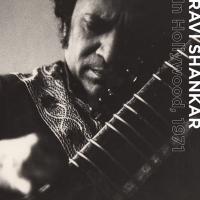Ravi Shankar's At Home Performance Led to The Concert For Bangladesh
However, that, and the fact that Harrison was in attendance, are hardly reasons for buying this record. The reasons would be that this is, in my admittedly unschooled in Indian music opinion, among the most accessible and passionate of Shankar's recorded performances, and that it is an intimately recorded performance that brings you into the room with the sitar great, his frequent accompanist tabla player Ustad Alla Rakha and tanpura (a drone instrument) player Kamala Chakravarty. Also all profits from the record go to benefit The Ravi Shankar Foundation, which serves to educate the world about Indian classical music and to preserve the f Ravi Shankar's archives.
Even lacking a fundamental understanding of the music's structure, this performance makes easy following the complex melodic development. You can "follow the tune" or "tunes" as they unwind and develop, anchored by the tabla and drone accompaniment.
Though this is a "home" recording, quite obviously professional recording gear was used, set up by professionals who knew what they were doing. Though the sides are long at around twenty minutes each, the absence of deep bass in the music allows the music to flow engraved in the grooves at a sufficiently high level to be well above the noise floor and without dynamic compression.
There are no lacquer cutting credits but there is a "tape transfer, audio restoration, and mastering" credit so you can assume lacquers were cut by whoever, from high resolution digital files. I think you'll approve of the sound regardless of source and the pressing quality (I think GZ) is excellent as is the gatefold package.
If you don't own any Ravi Shankar albums (back in 1967 almost everyone into The Beatles bought East Meets West with Shankar and Yehudi Menuhin just "because",though how many have played it in decades?) this one would be a good first one both because of the intimacy of the recording on two LPs, and because of the performance, which had me listening straight through all four sides (admittedly something I was not expecting to do!).
Maybe I've written this before, but back in the mid 1960s when George Harrison's sitar playing on "Norwegian Wood" had created an Indian music "craze", Shankar and his group played Cornell University's intimate Bailey Hall and my friends and I went ("zonked" of course). The stage was set with a large carpet on the floor and incense burning.
Shankar and his group seemed to float onto the stage as if they'd landed from another planet. We sat mesmerize by both the music and the exotica of the instruments, the people—the whole scene. When it was over the group exited the stage as they'd entered—as if on cushions of air—and then it was over and we were like "What was that?"
Of course by then "the munchies" had set in and back then literally there were only two places open where you could get something eat that late: Bud's Diner, downtown and The Howard Johnson's on Triphammer Road, which is where we went.
We were still abuzz about what we'd seen as we entered the HoJos and then much to our shock, surprise and disappointment at being brought down to earth, there in a corner table, was Ravi Shankar and the other musicians sitting there smoking cigarettes and eating fried clams and whatever else HoJo's was serving up.
They were not from another planet after all!



